 |
| July 05, 2016 | Volume 12 Issue 25 |
Electrical/Electronic News & Products
Designfax weekly eMagazine
Archives
Partners
Manufacturing Center
Product Spotlight
Modern Applications News
Metalworking Ideas For
Today's Job Shops
Tooling and Production
Strategies for large
metalworking plants
Isolated probing tech for fast-switching power device testing
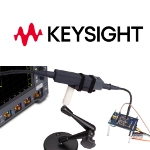 Keysight Technologies has developed an optically isolated differential probing family dedicated to enhancing efficiency and performance testing of fast-switching devices such as wide-bandgap GaN and SiC semiconductors. Validation of floating half-bridge and full-bridge architectures commonly used in power conversion, motor drives, and inverters requires measurement of small differential signals riding on high common-mode voltages. This measurement can be challenging due to voltage source fluctuations relative to ground, noise interference, and safety concerns.
Keysight Technologies has developed an optically isolated differential probing family dedicated to enhancing efficiency and performance testing of fast-switching devices such as wide-bandgap GaN and SiC semiconductors. Validation of floating half-bridge and full-bridge architectures commonly used in power conversion, motor drives, and inverters requires measurement of small differential signals riding on high common-mode voltages. This measurement can be challenging due to voltage source fluctuations relative to ground, noise interference, and safety concerns.
Learn more.
Protect sensitive electronics in explosive environments with new aluminum ATEX Cabinet Cooler Systems
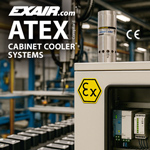 EXAIR's ATEX Cabinet Cooler® Systems deliver a powerful and affordable solution for keeping electrical enclosures cool in hazardous ATEX classified areas -- and they're now available in durable aluminum construction. Engineered for use in Zones 2 and 22, these coolers are UL tested, CE compliant, and meet stringent ATEX standards for purged and pressurized enclosures. With cooling capacities up to 5,600 Btu/Hr., ATEX Cabinet Coolers are ideal for preventing overheating in electrical cabinets. EXAIR offers a comprehensive lineup of systems.
EXAIR's ATEX Cabinet Cooler® Systems deliver a powerful and affordable solution for keeping electrical enclosures cool in hazardous ATEX classified areas -- and they're now available in durable aluminum construction. Engineered for use in Zones 2 and 22, these coolers are UL tested, CE compliant, and meet stringent ATEX standards for purged and pressurized enclosures. With cooling capacities up to 5,600 Btu/Hr., ATEX Cabinet Coolers are ideal for preventing overheating in electrical cabinets. EXAIR offers a comprehensive lineup of systems.
Learn more.
PLC handbook chock full of must-know information
 Automation-Direct's Practical Guide to Program-mable Logic Controllers Handbook has been improved with tons of new need-to-know info, making it a more comprehensive guide to the world of PLCs. Besides covering the basics of PLC history, PLC hardware, and PLC software, this guide takes you deeper into the ever-changing world of PLC communication, the importance of feedback loops, cyber security, and many other areas that are a must-know for any PLC novice or seasoned automation professional.
Automation-Direct's Practical Guide to Program-mable Logic Controllers Handbook has been improved with tons of new need-to-know info, making it a more comprehensive guide to the world of PLCs. Besides covering the basics of PLC history, PLC hardware, and PLC software, this guide takes you deeper into the ever-changing world of PLC communication, the importance of feedback loops, cyber security, and many other areas that are a must-know for any PLC novice or seasoned automation professional.
Get this great resource today.
Haptic feedback prototyping kit from TDK
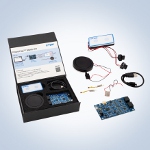 Get your customers to feel the difference your products make. TDK has released a development starter kit for fast haptics prototyping. It gives mechanical designers and engineers first impressions of the haptic feedback using PowerHap piezo actuators, shows how the mechanical integration works, and provides a reference design. Applications include automotive, displays and tablets, household appliances, vending machines, game controllers, industrial equipment, and medical devices.
Get your customers to feel the difference your products make. TDK has released a development starter kit for fast haptics prototyping. It gives mechanical designers and engineers first impressions of the haptic feedback using PowerHap piezo actuators, shows how the mechanical integration works, and provides a reference design. Applications include automotive, displays and tablets, household appliances, vending machines, game controllers, industrial equipment, and medical devices.
Learn more.
Mini ESD preset torque screwdriver
 Need precision fastening with ESD protection at the smallest torque levels? Mountz has you covered. The new FG Mini ESD Preset Torque Screwdriver is built for low-torque, high-precision tasks. Its compact design makes it ideal for tight spaces and small fasteners, while delivering the same reliable control and ESD protection users have come to expect from Mountz. Two models available: FG25z (3 to 25 ozf.in, 2 to 17.7 cN-m) and FG50z (20 to 50 ozf.in, 14.1 to 35.3 cN-m).
Need precision fastening with ESD protection at the smallest torque levels? Mountz has you covered. The new FG Mini ESD Preset Torque Screwdriver is built for low-torque, high-precision tasks. Its compact design makes it ideal for tight spaces and small fasteners, while delivering the same reliable control and ESD protection users have come to expect from Mountz. Two models available: FG25z (3 to 25 ozf.in, 2 to 17.7 cN-m) and FG50z (20 to 50 ozf.in, 14.1 to 35.3 cN-m).
Learn more.
Laumas load cells and electronics from AutomationDirect
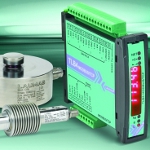 Automation-Direct has added Laumas precision-engineered load cells, transmitters, and accessories that deliver reliable performance in industrial weighing and force measurement applications. The FCAL series high-precision bending beam load cells are ideal for low- to mid-capacity systems. CTL series load cells are designed for both tension and compression, with excellent linearity. The CBL series low-profile compression load cells are perfect for space-limited applications. Laumas load cell transmitters are available too for precise monitoring and control. Very good pricing.
Automation-Direct has added Laumas precision-engineered load cells, transmitters, and accessories that deliver reliable performance in industrial weighing and force measurement applications. The FCAL series high-precision bending beam load cells are ideal for low- to mid-capacity systems. CTL series load cells are designed for both tension and compression, with excellent linearity. The CBL series low-profile compression load cells are perfect for space-limited applications. Laumas load cell transmitters are available too for precise monitoring and control. Very good pricing.
Learn more.
Engineer's Toolbox: What is ground loop feedback?
 Improper grounding can create problems in data logging, data acquisition, and measurement and control systems. One of the most common problems is known as ground loop feedback. Experts at CAS DataLoggers run through five ways to eliminate this problem.
Improper grounding can create problems in data logging, data acquisition, and measurement and control systems. One of the most common problems is known as ground loop feedback. Experts at CAS DataLoggers run through five ways to eliminate this problem.
Read the full article.
What is a braking resistor?
 According to Automation-Direct, "Braking resistors don't actually provide braking directly -- rather, they allow a drive to stop a loaded motor faster." Why is this important? Protect your AC or DC drive system from regenerative voltage that can create an over-voltage fault on the drive -- especially with high inertial loads or rapid deceleration.
According to Automation-Direct, "Braking resistors don't actually provide braking directly -- rather, they allow a drive to stop a loaded motor faster." Why is this important? Protect your AC or DC drive system from regenerative voltage that can create an over-voltage fault on the drive -- especially with high inertial loads or rapid deceleration.
View the video.
New Digital Static Meter: Precise measurement, easy use
 Static electricity isn't just a nuisance; it's a serious threat to manufacturing efficiency, product integrity, and workplace safety. Unchecked static can lead to costly downtime, product defects, material jams, and even hazardous shocks to employees. If static is interfering with your processes, EXAIR's upgraded Model 7905 Digital Static Meter offers an essential first step in identifying and eliminating the problem. With just the press of a button, this easy-to-use, handheld device pinpoints the highest voltage areas in your facility, helping you diagnose static issues before they become a problem.
Static electricity isn't just a nuisance; it's a serious threat to manufacturing efficiency, product integrity, and workplace safety. Unchecked static can lead to costly downtime, product defects, material jams, and even hazardous shocks to employees. If static is interfering with your processes, EXAIR's upgraded Model 7905 Digital Static Meter offers an essential first step in identifying and eliminating the problem. With just the press of a button, this easy-to-use, handheld device pinpoints the highest voltage areas in your facility, helping you diagnose static issues before they become a problem.
Learn more.
New laser cutting modulating strategy tested with Mikrotron high-speed camera
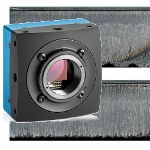 Modulating a laser beam's intensity distribution optimizes energy delivery to the process zone, resulting in better cutting speed, cut edge quality, and cut kerf geometry. Scientists in Belgium have come up with a new method that they say produces better cutting results.
Modulating a laser beam's intensity distribution optimizes energy delivery to the process zone, resulting in better cutting speed, cut edge quality, and cut kerf geometry. Scientists in Belgium have come up with a new method that they say produces better cutting results.
Read the full article.
All-in-one embedded PLC based on Raspberry Pi 4 -- build control applications
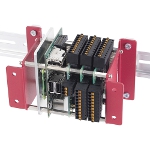 The new PLC CPI-PS10CM4 from Contec Co. is a compact embedded programmable logic controller (PLC) that is loaded with CODESYS, the world's most widely used software PLC. This product uses Contec's original single-board computer, which is based on Raspberry Pi's latest embedded module, the Compute Module 4 (CM4). By using the wide range of peripheral devices for Raspberry Pi, such as Contec's CPI Series, you can build various control applications in a PLC language that complies with the IEC 61131-3 international standard.
The new PLC CPI-PS10CM4 from Contec Co. is a compact embedded programmable logic controller (PLC) that is loaded with CODESYS, the world's most widely used software PLC. This product uses Contec's original single-board computer, which is based on Raspberry Pi's latest embedded module, the Compute Module 4 (CM4). By using the wide range of peripheral devices for Raspberry Pi, such as Contec's CPI Series, you can build various control applications in a PLC language that complies with the IEC 61131-3 international standard.
Learn more.
Torque sensors for fastening applications and more
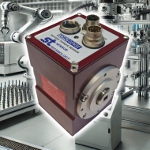 Saelig Company has introduced the Sensor Technology SGR525/526 Series Torque Sensors to provide precision torque monitoring that is critical for performance and safety. The square drive design (for applications with non-cylindrical shafts) allows for seamless integration into power tools, test rigs, industrial machinery, and precision fastening applications, ensuring superior torque measurement without the need for additional adapters or modifications. The SGR525 offers torque measurement only, while the SGR526 provides torque, speed, and power measurement using a 360-pulse-per-revolution encoder. Industries include automotive, aerospace, manufacturing, and research and development.
Saelig Company has introduced the Sensor Technology SGR525/526 Series Torque Sensors to provide precision torque monitoring that is critical for performance and safety. The square drive design (for applications with non-cylindrical shafts) allows for seamless integration into power tools, test rigs, industrial machinery, and precision fastening applications, ensuring superior torque measurement without the need for additional adapters or modifications. The SGR525 offers torque measurement only, while the SGR526 provides torque, speed, and power measurement using a 360-pulse-per-revolution encoder. Industries include automotive, aerospace, manufacturing, and research and development.
Learn more.
Wide-angle camera optimized for larger, faster conveyor belts
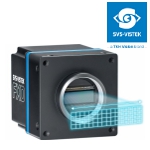 Wider conveyor belts operating at higher speeds are now commonplace in modern logistics. To keep up, SVS-Vistek is offering a cost-effective alternative to multi-camera systems with its fxo901CXGE 10-GigE color camera featuring the Sony IMX901-AQR wide-aspect global shutter 16.4-megapixel CMOS sensor. Unlike standard cameras, this unit captures targets in a wide field of view while maintaining high resolutions. The 4:1 horizontal aspect ratio allows one fxo901CXGE to replace an entire multi-camera system, removing the need for image synchronization.
Wider conveyor belts operating at higher speeds are now commonplace in modern logistics. To keep up, SVS-Vistek is offering a cost-effective alternative to multi-camera systems with its fxo901CXGE 10-GigE color camera featuring the Sony IMX901-AQR wide-aspect global shutter 16.4-megapixel CMOS sensor. Unlike standard cameras, this unit captures targets in a wide field of view while maintaining high resolutions. The 4:1 horizontal aspect ratio allows one fxo901CXGE to replace an entire multi-camera system, removing the need for image synchronization.
Learn more.
Handheld thermal imager cuts diagnostic time
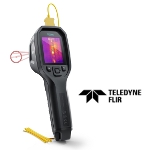 The FLIR TG268 is a next-generation thermal imager that provides professionals in the utility, manufacturing, electrical, automotive, and industrial sectors with a lightweight, handheld, affordable condition monitoring tool. Latest enhancements include higher temperature ranges, improved resolution, and larger data storage capacity. Go beyond the restrictions of single-spot IR thermometers to view and evaluate hot and cold spots that may signify potentially dangerous issues. Accurately measure temps from -25 to 400 C. Native thermal images improved with Super Resolution upscaling.
The FLIR TG268 is a next-generation thermal imager that provides professionals in the utility, manufacturing, electrical, automotive, and industrial sectors with a lightweight, handheld, affordable condition monitoring tool. Latest enhancements include higher temperature ranges, improved resolution, and larger data storage capacity. Go beyond the restrictions of single-spot IR thermometers to view and evaluate hot and cold spots that may signify potentially dangerous issues. Accurately measure temps from -25 to 400 C. Native thermal images improved with Super Resolution upscaling.
Learn more.
SOLIDWORKS 2025: Sheet metal design top features from an expert
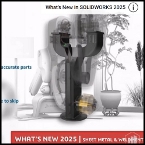 Find out what's new in SOLIDWORKS 2025 when it comes to sheet metal and weldments, and learn some valuable tips and tricks along the way from TriMech. Topics covered include copying cut list properties, bend notches, tab and slot enhancements, groove beads (a new type of weld bead), performance enhancements, and more. When you're done, check out TriMech's full YouTube channel filled with educational material.
Find out what's new in SOLIDWORKS 2025 when it comes to sheet metal and weldments, and learn some valuable tips and tricks along the way from TriMech. Topics covered include copying cut list properties, bend notches, tab and slot enhancements, groove beads (a new type of weld bead), performance enhancements, and more. When you're done, check out TriMech's full YouTube channel filled with educational material.
View the video.
Configurable analog chip computes with 1,000 times less power than digital
By Rick Robinson, Georgia Tech
Researchers at Georgia Tech have built and demonstrated a novel configurable computing device that uses a thousand times less electrical power -- and can be built up to a hundred times smaller -- than comparable digital floating-gate configurable devices currently in use.
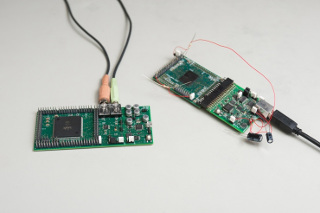
Examples of FPAA chips and printed circuit boards. [Credit: Fitrah Hamid, Georgia Tech]
The new device, called the Field-Programmable Analog Array (FPAA) System-On-Chip (SoC), uses analog technology supported by digital components to achieve unprecedented power and size reductions. The researchers said that for many applications these low-power analog-based chips are likely to work as well as or better than configurable digital arrays.
Currently, field programmable gate arrays (FPGAs) -- digital devices widely used in consumer devices, defense systems, and more -- dominate the configurable chip market. These floating-gate integrated circuits can be altered internally at any time, and techniques to reconfigure them for many different forms and functions are well established.
Professionals familiar with FPGAs will find the programming interface of the new analog chip surprisingly like the digital circuits in many ways, said Jennifer Hasler, a professor in the Georgia Tech School of Electrical and Computer Engineering (ECE) and leader of the research team that produced the new analog architecture.
"But in other ways, the FPAA is going to seem quite different," she said. "In terms of the power needed, it's extremely different because you need only milliwatts to run the analog device, while it's hard to get an FPGA to work on less than a watt."
A paper on the new FPAA system-on-chip device has been published on the IEEE Xplore website. Another paper focusing on the details of programming FPAA devices was also published on the Xplore site. In addition, a third paper, detailing a high-level open-source programming toolset developed by Hasler and her team for programming analog arrays, has also been published online in the Journal of Low Power Electronics and Applications.
Novel techniques
Traditionally, analog technology has been used primarily for hard-wired circuits such as sensors that interface between digital devices and the real world; examples include the circuits that detect and reproduce sound in cell phones and other devices. Analog circuits are also used extensively in electronics to regulate and optimize power use. These single-function circuits cannot perform software-based computation, using hardware gates and switches, in the manner of digital integrated circuits.
Hasler's team, however, has developed techniques that perform computation using an analog-style physical architecture by reliably positioning electrons in an FPAA's connective structure. This approach stands in contrast to FPGAs, which process electrons through floating gates in ways similar to conventional digital semiconductors such as memory chips or central processing units.
One advantage of FPAAs is that they're non-volatile, Hasler explained, meaning they retain data even when power is turned off. This is similar to flash memory technology, such as the solid-state drives and storage cards commonplace today. The use of non-volatile memory reduces power consumption, in contrast to the higher power needs of the volatile SRAM configurations typically used in FPGAs.
"In addition to being non-volatile, our analog architecture lets us do something fairly radical -- we can compute using the routing fabric of the chip, exploiting areas that are usually considered just dead weight," Hasler said. "To help do this, we've developed highly efficient switches that can be programmed on, off, or in-between -- partially on and partially off. This flexibility provides both increased computation capabilities and reduced power consumption."
Milliwatts or microwatts
The present FPAA device can operate on less than 30 mW -- thousandths of a watt, Hasler explained. That level approaches three orders of magnitude less than a conventional digital configurable chip. Further design advances in analog arrays could bring their power needs down into the microwatt range -- millionths of a watt.
To program the analog environment of the new device, researchers manipulate electrons in precise ways. Using electron-injection and electron-tunneling techniques, they erase data by lowering the number of electrons at specific locations in the device structure to the lowest possible value. Then they encode new data by increasing the number of electrons located at a given location up to an exact value.
This complex approach makes possible a highly dense chip structure that offers many parameters -- meaning programmable variables that can exist in a large number of different states and offer many shadings of behavior. It is this structural density that allows greater computing capability for a given degree of physical size and power input.
"Our FPAA chip has roughly half a million of these programmable parameters," Hasler said. "They can be used as a switch in a digital manner -- using the lowest possible value for 'off' or the highest possible value for 'on' -- or we can achieve even more rich behavior using intermediate values."
A new toolset
The FPAA device includes a small amount of built-in digital circuitry that supports communication within the chip and also helps run the programming infrastructure. Utilizing these support features, the team has developed an extensive set of high-level programming tools to take advantage of the new chip.
Among other things, the new toolset is designed to make working with analog arrays accessible to those familiar with digital designs like FPGAs, which are programmed using comparable high-level tools. The new toolset can both simulate and program the FPAA reconfigurable device. A paper detailing these high-level tools has been published online.
"Our toolset uses high-level software developed in the Scilab/Xcos open-source programs, with an analog and mixed-signal library of components," Hasler said. "Georgia Tech undergraduates are already using these tools in classes in the School of Electrical and Computer Engineering that cover mixed-signal and analog devices and tools."
One area in which the analog approach is notably powerful involves command words -- voice recognition technology used in devices like smartphones to do such things as wake up circuits from an off state, Hasler said. Like traditional analog sensing circuits, an FPAA offers excellent context-aware capability at extremely low power states.
Hasler said that she has talked with several companies about potential applications of the FPAA in commercial devices. A significant number of FPAA chips has already been produced, but plans for potential large-scale manufacture of the chips have not been finalized. The key technologies in the FPAA system-on-chip are patent pending.
"We believe that analog technology offers very powerful ways to look at physical computing, with considerable potential for commercial, neuromorphic, military, and other applications," Hasler said.
CITATIONS:
Sihwan Kim, et al., "Integrated Floating-Gate Programming Environment for System-Level ICs," (IEEE Transactions on Very Large Scale Integration (VLSI) Systems, 2015). http://dx.doi.org/10.1109/TVLSI.2015.2504118
Suma George, et at., "A Programmable and Configurable Mixed-Mode FPAA SoC," (IEEE Transactions on Very Large Scale Integration (VLSI) Systems, 2016). http://www.dx.doi.org/10.1109/TVLSI.2015.2504119
Michelle Collins, et al., "An Open-Source Tool Set Enabling Analog-Digital-Software Co-Design," (Journal of Low-Power Electronics and Applications, 2016). http://dx.doi.org/10.3390/jlpea6010003
Published April 2016
Rate this article
View our terms of use and privacy policy
